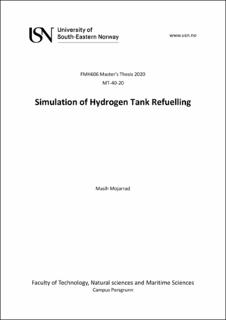| dc.description.abstract | As an alternative to fossil fuels and as a sustainable energy carrier, there are considerable
interestsin investigating hydrogen. Hence, it seems significant to evaluate the behavior of
hydrogen in refueling or storing. The most important issue in refueling the tank pertains
to the temperature. The hydrogen inside the tank heats up during the filling due to the
effect of compression and negative Joule-Thomson coefficient. As a result, the main aim
of this project is to examine the temperature inside the tank to not exceed 85°C in order to
avoid cracking in the wall and consequently, further possible disasters. This can be done
by implementing simulation with a proper software.
OpenFoam is an appropriate software to consider such behaviors and it contributes to
developing and considering the variety of properties including the temperature inside the
tank. The cylindrical geometry is created with blockMesh in 3D while the geometry ends
up with rectangular cubic in 2D. The proper boundary conditions and initial properties are
set up in rhoCentralFoam solver to establish simulations in OpenFoam 5.0.
According to the obtained results, it is found out that it seems necessary to precool inlet
hydrogen to fulfill the main purpose of this project. The bigger inlet area also decreases
the maximum temperature inside the tank however this effect is not that much
considerable compared to precooling. A further point to add is that the position of the inlet
can play a significant role in the final temperature. Acquired results prove that the
direction of inlet velocity should be aligned with the length of cylinder otherwise the
temperature increases significantly.
At last, comparing the final results to what was calculated and expected reveals that the
results have an acceptable concordance and consistency. So, it can be deduced that the
simulations have been done properly and the results can be trusted for further studies or
possible experiments. | en_US |
